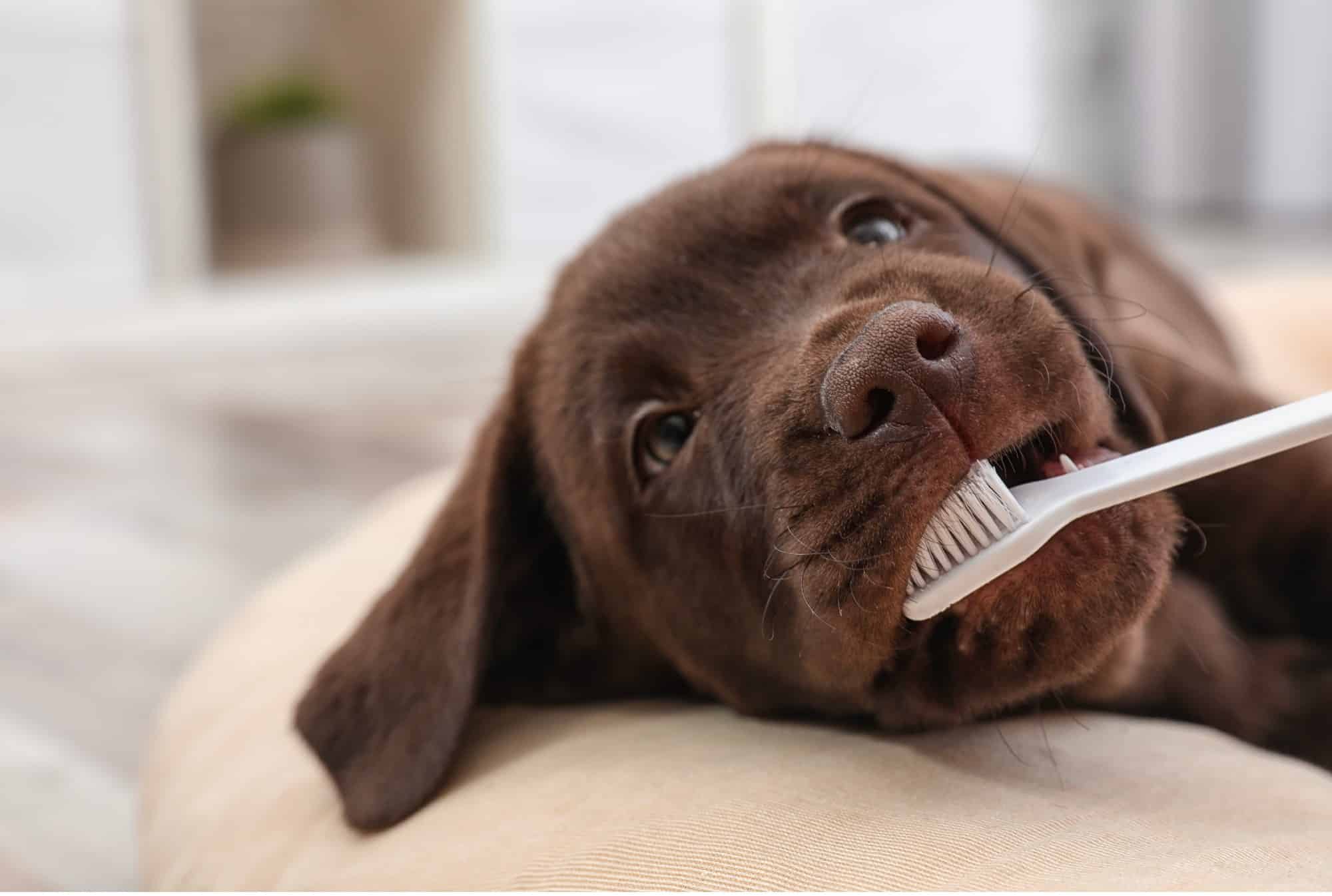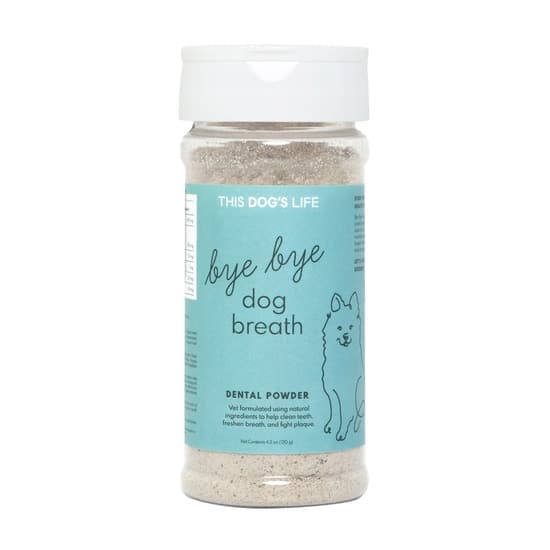While February is “pet dental health month,” a time to highlight the importance of taking care of your pup’s teeth, as dog parents, we need to be taking care of our bestie’s mouth every day of the year.
Dental disease is very often overlooked by pet owners because it can be hard to spot, says Dr. Patrik Holmboe, head veterinarian for veterinary telemedicine provider Cooper Pet Care. “Often by the time something is done about it, the issue has worsened to a serious state — potentially causing a lot of pain and discomfort to the poor animal,” he adds.
Indeed, over 80% of dogs show signs of dental disease by the time they turn 3 years old, according to research — a number that gets bigger the longer pet parents ignore the problem.
One of best things you can do to keep dog dental disease at bay is to look for signs of an unhealthy mouth. These can include bad breath, drooling, gums that bleed easily, and pawing at the face (a sign of pain and discomfort), according to Dr. Amy Attas, owner of house-call veterinary practice City Pets. Some dogs with dental disease might also refuse food because they’re in pain. As the disease gets worse and gums start to bleed more, you might notice blood inside water bowls or on toys.
Related: 8 Dog Breeds That Are at a Higher Risk of Getting Dental Disease
Unfortunately, it can take years for dog parents to notice just how bad their pup’s dental health is, so it is important to understand the stages.
The Four Stages of Dog Dental Disease
The American Animal Hospital Association (AAHA) divides periodontal (dental) disease into four stages, starting with mild tartar build up and progressing all the way to teeth and bone loss.
Stage 1. Gingivitis: This is the early stage of periodontal disease, characterized by inflammation of the gums. The gums may appear red, swollen, and bleed easily. Plaque and tartar accumulation on the teeth can cause irritation and inflammation of the gums. This stage is reversible with proper oral hygiene and professional dental cleaning.
Stage 2. Early periodontitis: In this stage, the inflammation has progressed to affect the ligaments and bones that support the teeth. The gums may recede and pockets may form between the teeth and gums. Plaque and tartar buildup continues to advance below the gumline, and bacteria start to damage the ligaments and bone that hold the teeth in place. The teeth may become loose, but they can still be saved with proper treatment.
Stage 3. Moderate periodontitis: The disease has advanced further, causing significant destruction of the supporting structures of the teeth, resulting in 25–50% attachment loss (meaning teeth may become loose or fall out). The pockets between the teeth and gums become deeper and more infected, and the ligaments and bone are severely damaged. The teeth may become loose and may need to be removed.
Stage 4. Advanced periodontitis: This is the most severe stage of the disease, characterized by extensive destruction of the supporting structures of the teeth, leading to tooth loss. The jawbone may also be affected. The gums are severely infected, and the dog may experience severe pain, difficulty eating, and jaw deformation. In this stage, there’s more than 50% of bone or teeth loss, and the infection may spread beyond the jawbone, affecting the liver, kidneys, and heart. It can even be deadly.
What You Can Do to Help Keep Your Dog’s Mouth Clean
Start with the basics
Regular teeth-brushing is the gold standard in dental care, and by far the most effective thing you can do to prevent dog dental disease, according to Dr. Holmboe. “Regular brushing with a soft-bristled toothbrush and toothpaste specifically formulated for dogs will help remove plaque and prevent tartar buildup,” she says.
This toothpaste takes headache out of brushing your dog’s teeth with its yummy flavor. Made of USDA organic ingredients, the edible toothpaste fights bad breath while balancing the oral flora to fight gum disease. The extract and baking soda acts as a mild abrasive and coconut oil has antimicrobial properties to help clean.
While Dr. Holmboe recommends brushing your dog’s teeth daily or at least three times a week (any number of times is better than none). “It’s important to start brushing your dog’s teeth when they are young to get them used to the process and make it a routine part of their grooming regimen,” he explains. “If you’re having trouble getting your dog to accept tooth brushing, you may want to consider starting slowly and gradually increasing the frequency and duration of brushing sessions over time.”
“Always look for products that carry the VOHC seal, which means that they are approved by the Veterinary Oral Health Council,” Dr. Attas adds.
Dental toys, chews, and treats
Chewing on dental toys and treats can help remove plaque and tartar, as well as massage the gums, according to Dr. Holmboe. Just keep in mind that these things should be complementary to tooth brushing, and are less effective if used alone.
“The dental chews are often designed in ways that also allow the chews to physically rub against the teeth in a pseudo-brushing action,” Dr. Holmboe explains. “Look for toys made of tough, durable materials that can stand up to heavy chewing.”
Developed by veterinarians, Bye, Bye Dog Breath Dental Sticks are full of natural ingredients to help keep your dog’s mouth clean by keeping plaque at bay, stopping bad bacteria from wreaking havoc and helping gums stay in tip-top shape.
Related: What You Need to Know About Probiotics for Dogs, According to Experts
Dr. Attas also recommends dog chews that are specifically labeled for dental care, and cautions against using tennis balls or other fuzzy toys as chews, as these can grind down the teeth and cause additional dental disease. “Look for chew toys made from semi-hard material that are made to be chewed on but not consumed,” she adds.
Dental sprays, gels and water additives
These can be added to water to help decrease tartar accumulation and are the equivalent to mouthwash for humans. They can be a great addition to a teeth-cleaning regime, but if you’re not brushing too, they won’t be nearly as effective, according to Dr. Holmboe.
Dental powder supplements, which can be added to food, are also available, and are a good option if your dog won’t drink water with additives mixed in.
Developed by veterinarians, Bye, Bye Dog Breath Dental Powder is packed full of natural ingredients to help keep teeth clean and free of plaque, while supporting gums and freshening breath.
Professional cleaning
While regular at-home preventive and routine care is key, professional cleaning is a must. Regular dental cleanings performed by a vet will help prevent or delay periodontal disease onset.
How frequently your dog will need cleaning depends on a lot of factors, including age, diet, and at-home brushing and cleaning. Genetics also plays a part. A study conducted by researchers from the Waltham Petcare Science Institute shows that tiny dogs (under 14 pounds) were up to five times more likely to be diagnosed with periodontal disease than big dogs (over 55 pounds).
If you suspect your dog is experiencing dental issues, talk to your vet. They’ll be able to come up with the best treatment and oral care plan for your pooch.






















